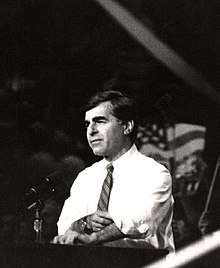Frederick P. Salvucci
| Frederick P. Salvucci | |
|---|---|
| Massachusetts Secretary of Transportation | |
|
In office 1975–1979 | |
| Governor | Michael Dukakis |
| Preceded by | Alan A. Altshuler |
| Succeeded by | Barry Locke |
|
In office 1983–1991 | |
| Governor | Michael Dukakis |
| Preceded by | James Carlin |
| Succeeded by | Richard L. Taylor |
| Personal details | |
| Born |
1940 (age 77–78) Brighton, Boston, Massachusetts |
| Residence | Brighton |
| Alma mater | Massachusetts Institute of Technology |
| Occupation | Civil Engineer |
Frederick Peter Salvucci is a civil engineer specializing in transportation. He was the Secretary of Transportation for the Commonwealth of Massachusetts under Governor Michael Dukakis. As of 2015, he is a Senior Lecturer in the Department of Civil and Environmental Engineering at the Massachusetts Institute of Technology (MIT).
Early life and education
Salvucci was born, and still lives, in the Brighton district of Boston.[1] He was graduated from Boston Latin School in 1957.[2] He attended Massachusetts Institute of Technology both as an undergraduate and graduate student of Civil Engineering, earning his Bachelor of Science in 1961 and his Master of Science in 1962.[3]
His international education includes a year at the University of Naples as a Fulbright Scholar from 1964 to 1965, where he studied the use of transportation investment to stimulate economic development in areas of high poverty in Southern Italy.
Career
Much of Salvucci's career has been in the public sector; he served from 1970 to 1974 as transportation advisor to Boston mayor Kevin White and then from 1975 to 1978 and 1983 to 1990 as Secretary of Transportation for the Commonwealth of Massachusetts under Dukakis. In those roles, he has participated in much of the transportation planning and policy formulation in the Boston urban area and the Commonwealth of Massachusetts over several decades.
During his tenure in government, he gave particular emphasis to the expansion of the transit system, the development of the financial and political support for the Central Artery/Tunnel Project (see Big Dig), and the design of implementation strategies consistent with economic growth in compliance with the Clean Air Act. Other efforts included the extension of the Red Line to Quincy and Alewife station in Cambridge; the relocation of the Orange Line in Boston's Southwest Corridor; the acquisition and modernization of the Commuter Rail Network; the restructuring of the MBTA; the formulation of noise rules to halt the increase in aircraft noise at Logan Airport; the development of strategies to achieve high-speed rail service between Boston and New York City; and planning for the redevelopment of the Park Square section of Boston by locating and building the State Transportation Building there.
More recent activities have included participation in the restructuring of commuter and rapid transit services in Buenos Aires, Argentina, using concession contracts with private-sector companies; participation with the Volpe Center in a review of the transportation planning process in United States metropolitan areas of over 1 million people; and participation in an innovative research and educational collaboration with the University of Puerto Rico and the Puerto Rico Highways and Transportation Authority, focused on the development of a new transit system for San Juan, Puerto Rico. The project, called Tren Urbano, is the first design-build-operate system in the United States. Salvucci is also a key participant in major (MIT) research projects with the Chicago Transit Authority and with Transport for London, patterned on the Tren Urbano program.
Other
Salvucci teaches courses in Urban Transportation Planning, Institutional and Policy Analysis, and Public Transportation at the Massachusetts Institute of Technology (MIT).
References
- ↑ "Great Projects: The Building of America . Interviews - PBS". Pbs.org. Retrieved 25 April 2018.
- ↑ "Notable Alumni". BLS-BLSA: Boston Latin School - Boston Latin School Association. Boston Latin School. Retrieved July 18, 2017.
- ↑ Alyssa, Danigelis (July 1, 2004). "The Man Behind the Big Dig". MIT Technology Review. Retrieved July 18, 2017.
Links
- United States Senate Committee on Environment and Public Works, epw.senate.gov; accessed April 25, 2018.

.jpg)